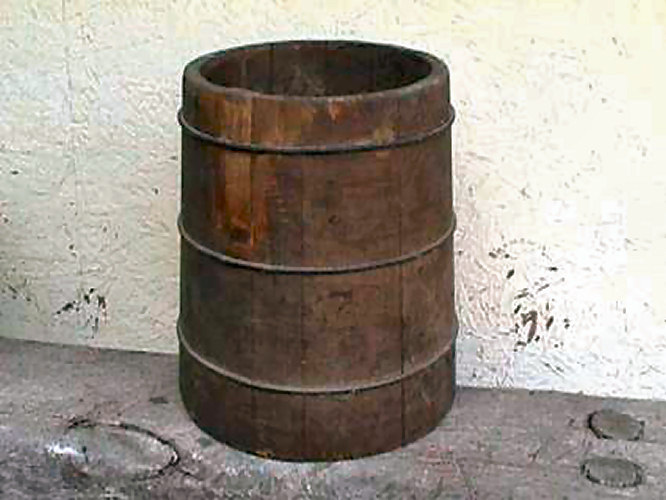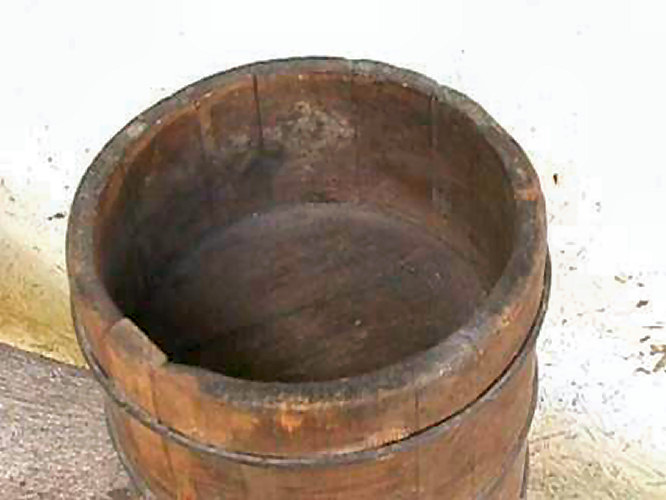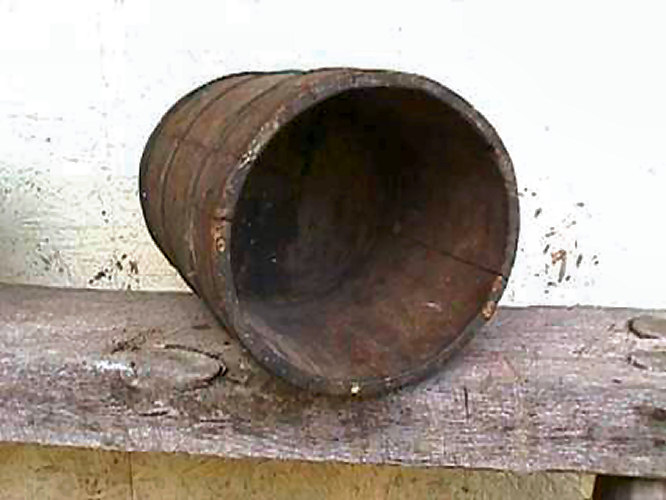


![]() The subject of this post is the peck/half-peck measure shown above.
The subject of this post is the peck/half-peck measure shown above.
![]() The word peck is derived from the Middle English word, pecke, which in turn was derived from either the Old French words, pek and/or picot, or from the Middle Low German word, pekken, all dating from the 13th Century. One source suggests that the word peck was derived from the Latin word picotus. The original meaning of the word is unknown, but it might have referred to the amount of oats fed to horses. A peck has, over the centuries, come to amount to one quarter of a bushel, or eight quarts in dry measure. It is a measure of volume rather than weight.
The word peck is derived from the Middle English word, pecke, which in turn was derived from either the Old French words, pek and/or picot, or from the Middle Low German word, pekken, all dating from the 13th Century. One source suggests that the word peck was derived from the Latin word picotus. The original meaning of the word is unknown, but it might have referred to the amount of oats fed to horses. A peck has, over the centuries, come to amount to one quarter of a bushel, or eight quarts in dry measure. It is a measure of volume rather than weight.
![]() The word cooper comes from kuper, a Lower Saxon word meaning "a tub", and was conferred on one who makes tubs, along with casks, barrels and similar items. It has been suggested that the idea of containing liquids inside a vessel constructed of wooden staves or slats arose from the shipbuilding industry. In the days of ships that were constructed of wood, the idea was to fit wooden boards tightly together so that the liquid of the ocean waters would be kept out. Someone must have looked at that and realized that if you could keep the ocean water out of a wooden ship, you might likewise keep liquids inside a similarly constructed wooden vessel. A cooper might make nothing but containers other than casks. In that case, he was called a white cooper.
The word cooper comes from kuper, a Lower Saxon word meaning "a tub", and was conferred on one who makes tubs, along with casks, barrels and similar items. It has been suggested that the idea of containing liquids inside a vessel constructed of wooden staves or slats arose from the shipbuilding industry. In the days of ships that were constructed of wood, the idea was to fit wooden boards tightly together so that the liquid of the ocean waters would be kept out. Someone must have looked at that and realized that if you could keep the ocean water out of a wooden ship, you might likewise keep liquids inside a similarly constructed wooden vessel. A cooper might make nothing but containers other than casks. In that case, he was called a white cooper.

![]() The kinds of things the white cooper made included: buckets, piggins and peck/half-peck measures, in which the ‘head’ was installed part way between the two ends. The head was so positioned so that two different dry measurements could be obtained from the single cask, such as shown in the accompanying illustrations.
The kinds of things the white cooper made included: buckets, piggins and peck/half-peck measures, in which the ‘head’ was installed part way between the two ends. The head was so positioned so that two different dry measurements could be obtained from the single cask, such as shown in the accompanying illustrations.

![]() One might wonder why the peck/half-peck measure was created. A half-peck measure simply needed to be filled twice to obtain the amount that would fill the peck measure. So what was the point of constructing a single container that measured both, pecks and half-pecks? I have searched high and low for an answer to this question, but have have no luck. Perhaps the cooper who initially created it, thought that the peck and half-peck sizes were good one to work with. A bushel/half-bushel measure would have been too large for anyone to handle easily, while wooden containers smaller than the peck/half-peck size would have been less than convenient to use. Apparently the first cooper to construct the peck/half-peck measure realized that it was an ideal size for a combined measuring container.
One might wonder why the peck/half-peck measure was created. A half-peck measure simply needed to be filled twice to obtain the amount that would fill the peck measure. So what was the point of constructing a single container that measured both, pecks and half-pecks? I have searched high and low for an answer to this question, but have have no luck. Perhaps the cooper who initially created it, thought that the peck and half-peck sizes were good one to work with. A bushel/half-bushel measure would have been too large for anyone to handle easily, while wooden containers smaller than the peck/half-peck size would have been less than convenient to use. Apparently the first cooper to construct the peck/half-peck measure realized that it was an ideal size for a combined measuring container.
